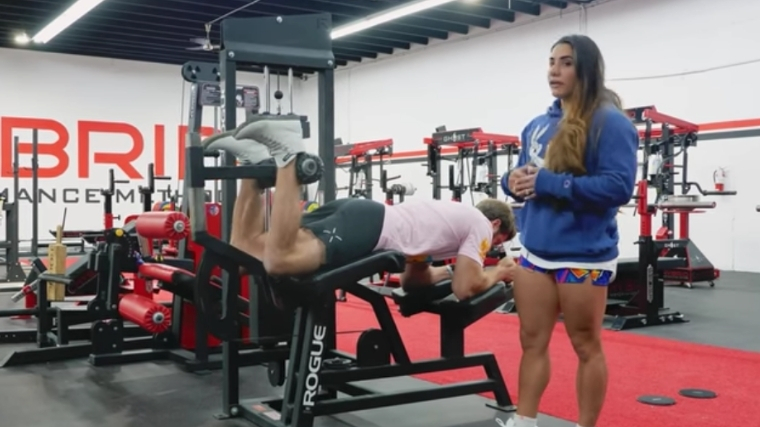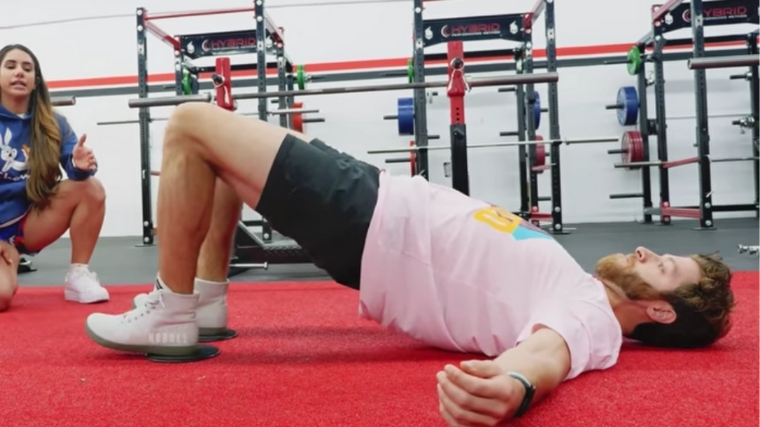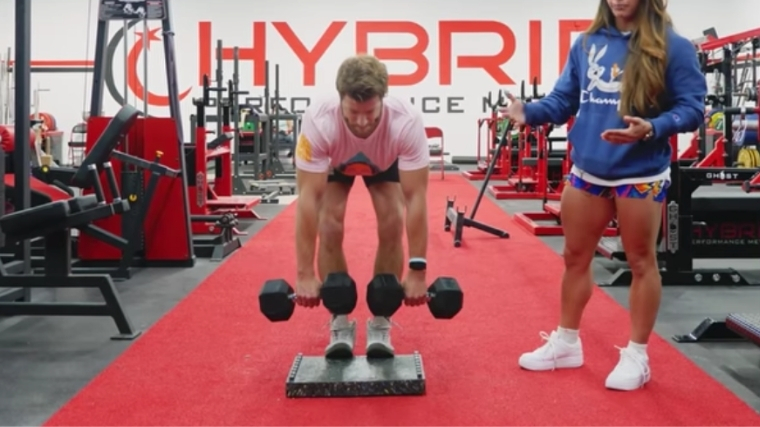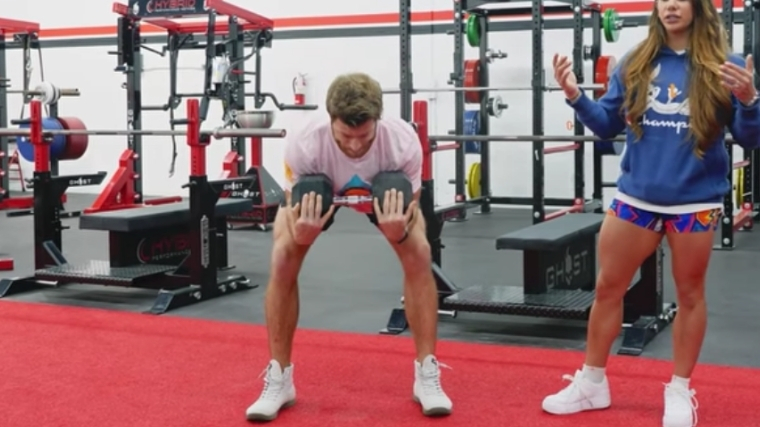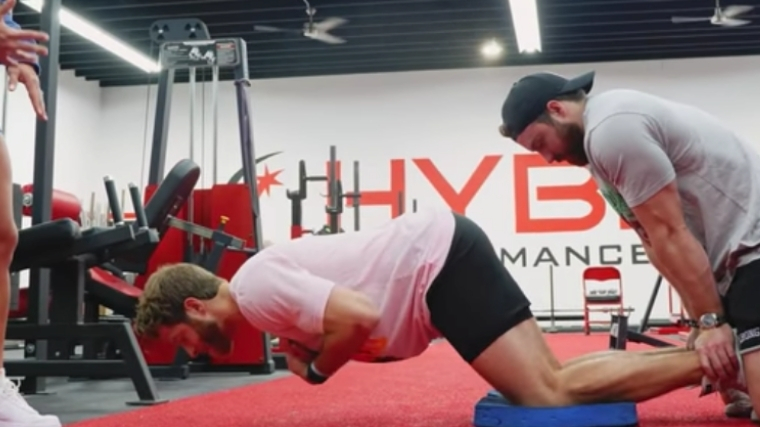If you have weak hamstrings, then there’s a strong chance you’re not maxing out on your strength potential for squats and deadlifts. Plus, lack of hamstring eccentric strength is a known cause of hamstrings strains. Paying attention to them is great for performance, aesthetics, and injury prevention.
Since the hamstrings are extensors at the hip and flexors at the knees, they play an important role in your performance, so it pays to train both ways. With some help from multi-powerlifting world record holder Dr. Stefi Cohen, we break down the best hamstring exercises below for performance, strength, and hypertrophy.
Best Hamstring Exercises
- Lying Leg Curl
- Hamstring Slide
- Toes-Elevated Dumbbell Romanian Deadlift
- Dumbbell Good Morning
- Razor Curl
- Single-Leg Stability Ball Curl
- Nordic Hamstring Curl
- Eccentric Hip Extension Hamstring Curl With Sliders
- Kettlebell Swing
- Glute-Hamstring Raise
- Barbell Good Morning
- Romanian Deadlift
- Single-Leg Deadlift Romanian Deadlift
- Cable Pull-Through
- Banded Hamstring Curl
Editor’s note: The content on BarBend is meant to be informative in nature, but it shouldn’t take the place of advice and/or supervision from a medical professional. The opinions and articles on this site are not intended for use as diagnosis, prevention, and/or treatment of health problems. Speak with your physician if you have any concerns.
Hamstring Exercises Video
In the video below, former BarBend Editor Jake Boly demonstrates five of the following moves as Cohen walks you through how and why to do them.
[Related: Everything You Need to Know to Build Your First Workout Program]
Lying Leg Curl
The lying leg curl is underappreciated, and it’s often done with poor form. But when performed correctly and with a full range of motion, this exercise strengthens your hamstring and calf muscles. Keep your hips and upper body steady to ensure that you’re only moving from your hamstrings.
[Related: What You Need to Know About How to Increase Strength]
Benefits of the Lying Leg Curl
- The lying leg curl isolates and strengthens the hamstrings as knee flexors.
- It helps improve hamstring flexibility when used with a full ROM.
- Trains the calf muscles.
How to Do the Lying Leg Curl
Lie face down on the leg curl machine. Slip the backs of your ankles under the pad and keep your hips down. Draw the belly button inwards to avoid movement compensations. Curl the weight towards your glutes. Lower slowly to maximize time under tension during the eccentric portion. Rinse and repeat.
Hamstring Slide
The hamstring slide makes use of your hamstrings in their function as a hip extender and a knee flexor. This exercise is easier than the razor curl (see below). You may opt to start with this one to boost your eccentric hamstring strength to help prevent hamstring strains. Another benefit is that it requires no weight to load the muscle, so it’s joint-friendly.
[Related: Best Pre-Workout Supplements for Strength, Cardio, and More]
Benefits of Hamstrings Slides
- Increases eccentric hamstring strength to help prevent hamstring strains and improve squat and deadlift performance.
- Easier exercise to do than the razor and Nordic curl.
How to Do Hamstring Slides
Lie down on your back with your legs bent at 90 degrees and your heels underneath your knees. The heels should be on a pair of workout sliders. (If you’re doing this at home, you can place your heels on a pair of socks on a hardwood floor.) Squeeze your glutes to raise your hips and lower your heels away from your body until your legs are almost fully extended. Then flex your hamstrings to bring your heels back underneath your knees and repeat.
Toes-Elevated Dumbbell Romanian Deadlift
Romanian deadlifts are a great accessory exercise for deadlifts and add strength and mass to your glutes and hamstrings. The toes-elevated variation takes this to a new level. Elevating the toes shifts the weight back on your heels, further isolating and strengthening your hamstrings. And when performed with a slow eccentric, it’ll help reinforce strength in a lengthened position to ward off unwanted strains.
[Related: The 8 Best Barbell Exercises for Mass, Strength, and Power]
Benefits of the Toes-Elevated Dumbbell RDL
- The elevated heels further isolate the glutes and hamstrings for more muscle-building and strength potential.
- Increases hamstring eccentric strength to help prevent hamstring strains.
How to Do the Toes Elevated Dumbbell RDL
Find a 25-pound bumper plate or low platform to elevate the toes and bring the feet close together. As you hinge, reach the dumbbells out so they’re tracking over the toes instead of keeping them close to the body. Control the eccentric tempo to feel the stretch properly, pause for a second in the bottom position, and hinge back up.
Dumbbell Good Morning
The barbell good morning is a great exercise to load the hamstrings, but not everyone has the shoulder mobility to reach behind them to stabilize the barbell. Or, after all the compressive/shear load on the spine from squatting and deadlifting, your spine needs a break. Enter the dumbbell good morning, which engages the anterior core, trains the same muscles as the barbell version but without the load on your spine. Having the weight anteriorly makes you more aware of upper body positioning too.
[Related: The Ultimate Guide On How to Choose a Barbell]
Benefits of the Dumbbell Good Morning
- Positioning of the dumbbell engages the anterior core and is easier on the lower back and shoulders than the barbell variation.
- Strengthens the lower back, hamstrings, and glutes at the same time.
How to Do the Dumbbell Good Morning
Hold a heavy dumbbell against your chest, keeping your shoulders down and chest up. Maintaining a soft bend in your knees, hinge at your hips until your torso is almost parallel to the ground, keeping your back in neutral. Pause for a second and return to the starting position, and repeat.
Razor Curl
The razor curl is a slight twist on the Nordic curl that has you maintain flex hips. Flexing the hip allows for a more intense contraction of the hamstring at the hip and a more forceful contraction of the hamstrings at the knee. Plus, it’s been shown to decrease the susceptibility of anterior cruciate ligament injury. But be warned, this exercise is advanced and should be performed when you have built up your eccentric hamstring strength. (1)
[Related: The Best Kettlebells for Beginners, CrossFit, and Cardio]
Benefits of the Razor Curl
- Improves the eccentric strength of the hamstrings and increases glute strength
- Increases core strength due to falling forward with control.
How to Do the Razor Curl
Have a training partner hold your feet or use a barbell/piece of equipment to anchor your lower body. Slight flex your hips and hold this position for the entire exercise. Fall forward while controlling the eccentric and lightly touch the ground. Use your hands to assist on the concentric if you’re starting to help make it easier.
Single-Leg Stability Ball Curl
The single-leg hip extension hamstring curl also helps work your hamstrings are both extensors and flexors (for your hips and knees respectively). The unstable element added by working with a stability ball forces you to be more disciplined with your technique and makes your stabilizer muscles work harder. When you emphasize the eccentric with this exercise, you’ll go a long way to bulletproofing your hamstrings. (2)
[Related: Build Muscle Anywhere With the Best At-Home Bodyweight Workouts]
Benefits of the Single-Leg Stability Ball Curl
- Strengthens the hamstrings, hip extensors, and knee flexors.
- The increased stabilization demands improve hip and core stability
- A great exercise for runners as the stability ball mimics the unevenness of road running.
How to Do the Single-Leg Single-Leg Stability Ball Curl
Lay on your back, place both feet on a stability ball with one leg bent, and engage your glutes. Raise your hips and lift one leg off of the ball. Now, curl the ball toward your butt with the working leg. Slowly reverse the movements and lower your hips to the floor, and repeat.
Nordic Hamstring Curl
Similar to the razor curl and a little easier to do — but not by much — the Nordic hamstring curl is the real deal. The eccentric strength of your hamstrings is the only thing stopping you from crashing face-first on the floor.
This hamstring exercise has been shown to decrease the risk of hamstring injuries by 51 percent compared with those who didn’t do it. (3) That’s a hefty improvement, especially if your hamstrings are prone to strains.
Benefits of the Nordic Hamstring Curl
- This move might help reduce your risk of hamstring strains.
- The Nordic hamstring curl is a fantastic exercise for improving hamstring hypertrophy.
- You’ll improve your mental focus, because you’ll need a lot of it to safely execute this lift.
How to Do the Nordic Hamstring Curl
Kneel on both knees. Secure your ankles with equipment or have a partner hold them for you. Engage your hamstrings, glutes, and abs. Keep your back neutral. Slowly lean forward, using only your hamstrings until you catch yourself with your hands or gently reach the ground. Push yourself back up. Repeat.
Eccentric Hip Extension Hamstring Curl With Sliders
The eccentric hip extension hamstring curl with sliders trains your hamstrings as a knee flexor and a hip extender. This strengthens your hamstrings in two ways — double the gains, double the fun.
There is no concentric contraction with this variation, which means you’re focusing exclusively on the lengthening of your hamstrings. That’s crucial for deadlifting strength and control. It also means that this exercise is a great starting point when you’re looking to improve your eccentric hamstring strength.
Benefits of the Eccentric Hip Extension Hamstring Curl With Sliders
- You’ll improve the eccentric strength of your hamstrings, which is key for controlling your deadlifts.
- This move strengthens your hamstrings as both a knee flexor and hip extender.
- It’s a great variation of the Nordic hamstring curl that many people may find more accessible.
How to Do the Eccentric Hip Extension Hamstring Curl With Sliders
Lie down on your back. Keep a neutral spine. Bend your knees. Place sliders underneath your heels. Point your toes toward the ceiling. Squeeze your glutes to raise your hips. With control, slowly press your heels down and out. Straighten your legs until they’re on the ground. Slide your heels back. Repeat.
Kettlebell Swing
Kettlebell swings target your glutes and hamstrings for improved strength, power, and endurance. Plus, swinging a kettlebell trains stability and stabilizer muscles across your entire body. That’s because you’re constantly adjusting to the shifting center of mass with each repetition.
Kettlebell swings train your hamstrings to be powerful hip extensors — which you definitely need for a strong deadlift lockout. Speaking of deadlifts, kettlebell swings also help develop some serious grip strength, which you’ll need to support all that lockout strength.
Benefits of the Kettlebell Swing
- Kettlebell swings train your hamstrings for power, strength, and endurance.
- This move helps improve hip extension strength and power, which can help improve your deadlift lockout.
- You’ll get the added benefits of improved cardiovascular endurance and grip strength.
How to Do the Kettlebell Swing
Stand with your feet wider than shoulder-width apart. Place the kettlebell just in front of you. Hinge down to grip the kettlebell. Squeeze your armpits. Raise your chest. Hike the kettlebell behind you. Thrust your hips forward. Use this momentum to swing the kettlebell. Finish by squeezing your glutes and quads as the kettlebell reaches chest height. Repeat in a continuous loop for reps.
Glute-Hamstring Raise
The glute-hamstring raise (GHR) develops eccentric strength in your hamstrings and builds killer hamstrings and glutes. The lower back, hamstrings, and glutes are working together as a unit which is often the case for a lot of exercises that involve the hamstrings.
The GHR is a great exercise that can be performed for higher reps with body weight to increase glute, hamstring, and lower back hypertrophy.
Benefits of the Glute-Hamstring Raise
- Develops eccentric strength in your hamstring to help prevent hamstring strains.
- Extended time under tension for glutes, hamstrings, and lower back to help build strength and endurance.
- Can be progressed by adding load when bodyweight is mastered.
How to Do the Glute-Hamstring Raise
Adjust the GHR so your feet are secured, and your quads are resting on the middle of the pad, making sure you have enough space to lower your torso. Your knees are bent at 90 degrees and your body is straight. Then push your toes into the pad and extend your knees. With your arms folded across your body slowly lower your torso forward until you are horizontal. Return to the starting position by contracting your hamstrings. Reset and repeat.
Barbell Good Morning
The barbell good morning trains your lower back, glutes, and hamstrings as a unit. You’ll put your glutes and hamstrings through a big range of motion to increase your muscle-building potential while boosting your posterior strength.
This move requires a lot of shoulder mobility to keep the bar in place. If that’s an issue for you, feel free to switch it up to dumbbell good mornings.
Benefits of the Barbell Good Morning
- This move promotes glute strength and hypertrophy.
- You’ll engage your entire posterior chain and all the spinal stabilizers that help prevent spinal flexion.
- You can load this move heavier the dumbbell good morning variation.
How to Do the Barbell Good Morning
Set up a loaded barbell in a power rack. Position and unrack the bar as though you were going to perform a back squat. Walk the bar out. With a slight bend in your knees, hinge at your hips. Keep your chest up and shoulders down. Hinge until your torso is almost parallel to the floor. Contract your glutes and hamstrings to bring you back to standing. Reset and repeat.
Romanian Deadlift
The Romanian deadlift (RDL) is a close cousin of the standard deadlift. But instead of going all the way to the floor between reps, RDLs will have you stop the bar at mid-shin level. This tweak keeps constant tension on your hamstring and glute muscles. That tension makes RDLs a better option for adding mass to these muscles.
The RDL may be less stressful on your body than a conventional deadlift, as it doesn’t allow you to use as much weight. Still, you can take advantage of using a lighter weight to maximize hypertrophy.
Benefits Of The Romanian Deadlift
- This move provides constant tension to your glutes and hamstrings, making them ideal for stimulating muscle growth.
- Since you can’t load RDLs as heavily, they allow you to train your hip hinge with less overall stress to your body than conventional deadlifts.
- Romanian deadlifts can help improve your lockout strength for conventional deadlifts.
How to Do the Romanian Deadlift
Stand tall with your feet hip-distance apart. Grip the barbell with an overhand grip in front of the thighs. Keep your chest up and shoulders down. Take a deep breath in. Hinge until the barbell is just below your knees. Always keep the barbell close to your body. Keep your lats engaged. Squeeze your glutes to hinge back to a standing position. Reset and repeat.
Single-Leg Deadlift Romanian Deadlift
The single-leg RDL is quite a tricky lower body movements, but it’s worth it if you can pull it off. You’ll improve your balance, reduced muscle imbalances, boost muscular hypertrophy, and increase your glute and hamstring endurance.
Working with one leg at a time forces you to slow down the eccentric. That builds all-important eccentric hamstring strength to bulletproof your hamstrings. Master this move with bodyweight first before adding load — because falling flat on your face will not be your finest moment.
Benefits of The Single-Leg Romanian Deadlift
- The single-leg RDL uncovers and reduces asymmetries between sides for increased lower body resilience.
- You’ll increase hypertrophy and endurance of the glutes and hamstrings.
- This move improves the balance and stability of your ankles, knees, hips, and lower back.
How to Do the Single-Leg Romanian Deadlift
Stand with your feet hip-width apart. Pick one foot up off the floor. Find balance on your grounded foot. Soften your working knee. Keep your chest up and shoulders down. Hinge your hip back. Try not to rotate your working hip upwards. Hinge until your belly button is facing the floor. Stabilize and return to the starting position. Repeat.
Cable Pull-Through
The cable pull-through is a pure hip hinge exercise that trains your glutes and hamstrings. You’ll have constant tension throughout the range of motion since you’re working with cables. This will be a boon to your glute and hamstring hypertrophy goals.
The cable pull-through forces you to sit back in your hips and will strengthen glute lockout strength. This has great carryover to more demanding hip hinge variations. Since you won’t be loading your lower back, this is also a helpful exercise for athletes wanting to add glute and hamstring volume while taking it easy on their lumbar spine.
Benefits of the Cable Pull-Through
- The cable pull-through reinforces good hip hinge mechanics while taking it easy on your lower back.
- The constant tension of the cable machine on your hamstrings and glutes helps build more muscle.
- This move improves hamstring and glute lockout strength, which has direct transfer to more demanding hip hinge exercises.
How to Do the Cable Pull-Through
Attach a rope to the cable set on its lowest setting. Turn around and face away from the machines with the rope attachment between your legs. Face your palms toward each other. Take a few steps away from the machine until you feel tension in the cable. Set your feet hip-width apart. Hinge down while keeping a neutral spine. Squeeze your glutes to reverse the movement. Reset and repeat.
Banded Hamstring Curl
You might perform hamstring curls on a machine, which helps isolate your hamstrings for growth. But one major advantage of the banded hamstring curl is the ascending resistance of the band. The further the band stretches, the harder your hamstrings have to work.
With a regular machine or weighted variation, the move gets easier toward the top. Conversely, this move will get harder. That way, you’re training a more complete range of motion. This helps your hamstrings grow by boosting time under tension and strength during all phases of motion.
Benefits of the Banded Hamstring Curl
- The band provides accommodating resistance that further strengthens your hamstrings by increasing time under tension across various ranges of motion.
- This variation is a great leg curl option if the machine is not available.
- The resistance band is easier on your joints compared to the lying leg curl machine.
How to Do the Banded Hamstring Curl
Anchor a looped resistance band to a sturdy object. Lie on your stomach with your feet hip-width apart. Face away from the anchor. Put your feet on either side of the band. Looping them securely around your heels. Squeeze your glutes to flatten your lower back. Pull your heels towards your glutes. Keep your hips and quads on the ground. Stop when you cannot pull any further. Slowly lower to the starting position and repeat.
All About the Hamstrings
Think of your hamstrings like the brakes on a car. They help control the descent when squatting, hinging, and jumping. When quickly changing directions on the court or field, strong hamstrings help you absorb force before applying it in a different direction. They are your main knee stabilizers, and their strength and flexibility go a long way in keeping your knees healthy.
During deadlifts, the quads are needed for the first part of the pull. After that, your hamstrings work mainly to extend the hips and to control the eccentric during the negative. You know you’ve performed your deadlifts correctly when your hamstrings are sore.
Anatomy of the Hamstrings
Your hamstrings consist of three muscles, and understanding what they are and how they work is important in obtaining a stronger posterior. The hamstrings are a group of three muscles on the backs of your thigh: the biceps femoris (long and short head), semitendinosus, and semimembranosus.
Each hamstring muscle pitches in to help with the following moves in the following ways:
- Hip Hyperextension: Glute Kickback
- Knee Flexion: Squat; Hamstring Curl Variations
- Hip Extension: Squat; Deadlift; Hip Thrust
Benefits of Training Your Hamstrings
Training your hamstrings will go a long way in keeping your knees healthy. As the hamstrings attach to the pelvis, their length and strength play a role in hip/torso positioning and good posture. Here are a few other important benefits of training your hamstrings.
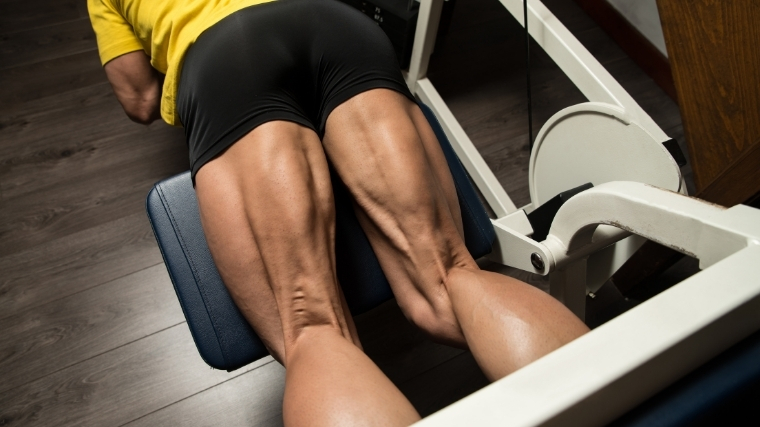
Injury Prevention
Hamstrings strains don’t happen when the knee is flexing concentrically. They happen when they extend eccentrically. It’s been shown that eccentric knee flexor exercises reduce the risk of hamstring strains because of improvements in eccentric knee flexor strength and the length of the biceps femoris. (1) Without sufficient hamstring strength, you can develop strength and size imbalances between the quadriceps and hamstrings, which increases injury risk to the knee and hamstring.
Run Faster and More Efficiently
Strength training the hamstrings helps you run faster by improving your neuromuscular coördination, power, and VO2 max. It also improves your running economy through better movement coördination and stride efficiency. (4)
Improved Deadlift And Squat Technique
If you have a strength imbalance between your hamstring and quads, strengthening your hamstrings will improve your eccentric control on hinges and squats and your lockout strength on deadlifts.
How to Warm-Up Your Hamstrings
It is important to warm up the hamstrings for the work ahead to improve performance and prevent injury. You’ll improve circulation to the hamstrings, zone in mentally, and prime your body to lift heavier weights. You need to pay special attention to your hamstring if you’re performing exercises that demand eccentric strength like hinges and sprinting.
Stretching them will not cut it. Instead, perform a set of hamstring slides and a set of passive leg lowering as part of your warm-up. Your hamstrings will thank you.
Ham it Up
Strong hammies are a must-have for lifters who want to build muscular thighs all while pulling heavier weights. If your training program is currently neglecting those sweet posterior leg gains, you might find your numbers stalling. You might even be more prone to painful tweaks in your thighs during heavy lifts. Whether your main goal is to strengthen your deadlift or to grow yourself some tree trunks, these are 15 of the best hamstring builders in the business.
References
- Gretchen D Oliver 1, Christopher P Dougherty The razor curl: a functional approach to hamstring training. J Strength Cond Res 2009 Mar;23(2):401-5.doi: 10.1519/JSC.0b013e31818f08d0
- Matthew N Bourne et al. An Evidence-Based Framework for Strengthening Exercises to Prevent Hamstring Injury. Sports Med. 2018 Feb;48(2):251-267. doi: 10.1007/s40279-017-0796-x.
- Wesam Saleh A Al-Attar et al. Effect of Injury Prevention Programs that Include the Nordic Hamstring Exercise on Hamstring Injury Rates in Soccer Players: A Systematic Review and Meta-Analysis. Sports Med. 2017 May;47(5):907-916. DOI: 10.1007/s40279-016-0638-2.
- M Chtara et al. Effects of intra-session concurrent endurance and strength training sequence on aerobic performance and capacity. Br J Sports Med. 2005 Aug; 39(8): 555–560.
